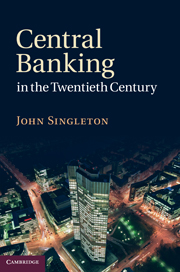Book contents
- Frontmatter
- Contents
- List of illustrations
- Acknowledgements
- List of abbreviations
- 1 A beginner's guide to central banking
- 2 Very boring guys?
- 3 Wind in the willows: the small world of central banking c. 1900
- 4 Something for everyone: new central banks, 1900–1939
- 5 A series of disasters: central banking, 1914–1939
- 6 The mysteries of central bank cooperation
- 7 The first central banking revolution
- 8 No time for cosmic thinkers: Central banking in the ‘Keynesian’ era
- 9 Rekindling central bank cooperation in the Bretton Woods era
- 10 The goose that lays the golden egg: Central banking in developing countries
- 11 The horse of inflation
- 12 The second central banking revolution: Independence and accountability
- 13 Reputations at stake: financial deregulation and instability
- 14 Inflation targeting: the holy grail?
- 15 The long march to European monetary integration
- 16 A world with half a million central bankers
- References
- Index
4 - Something for everyone: new central banks, 1900–1939
Published online by Cambridge University Press: 04 February 2011
- Frontmatter
- Contents
- List of illustrations
- Acknowledgements
- List of abbreviations
- 1 A beginner's guide to central banking
- 2 Very boring guys?
- 3 Wind in the willows: the small world of central banking c. 1900
- 4 Something for everyone: new central banks, 1900–1939
- 5 A series of disasters: central banking, 1914–1939
- 6 The mysteries of central bank cooperation
- 7 The first central banking revolution
- 8 No time for cosmic thinkers: Central banking in the ‘Keynesian’ era
- 9 Rekindling central bank cooperation in the Bretton Woods era
- 10 The goose that lays the golden egg: Central banking in developing countries
- 11 The horse of inflation
- 12 The second central banking revolution: Independence and accountability
- 13 Reputations at stake: financial deregulation and instability
- 14 Inflation targeting: the holy grail?
- 15 The long march to European monetary integration
- 16 A world with half a million central bankers
- References
- Index
Summary
It has generally been agreed … that when the direction of public finance is in the hands of a ministry responsible to a popularly elected Legislature, a ministry which would for that reason be liable to frequent change with the changing political situation, it is desirable that the control of currency and credit in the country should be in the hands of an independent authority which can act with continuity … indeed the only practical device for securing this independence and continuity is to set up a Central Bank, independent of political influence.
Sir George Schuster, Finance Member of the Viceroy's Council, 1933 (Simha 1970: 38–9)The central banking gospel was spread far and wide between 1900 and 1939. The Federal Reserve System, which came into operation in 1914, has pride of place in this chapter. However, in the 1920s and 1930s central banks were established in a range of countries in central and eastern Europe, the British empire, and Latin America. The motives of those who set them up were many and various, and indeed they often disagreed over the nature of the benefits that they would confer. Questions of institutional design, governance, and goals proved equally controversial.
After 1918, central banking proliferated in the context of global political and economic turmoil. Post-war instability and reconstruction lasted until the mid 1920s. Following a brief respite, the world economy plunged into depression in the early 1930s, and had barely recovered by the outbreak of the Second World War in 1939.
- Type
- Chapter
- Information
- Central Banking in the Twentieth Century , pp. 50 - 68Publisher: Cambridge University PressPrint publication year: 2010



